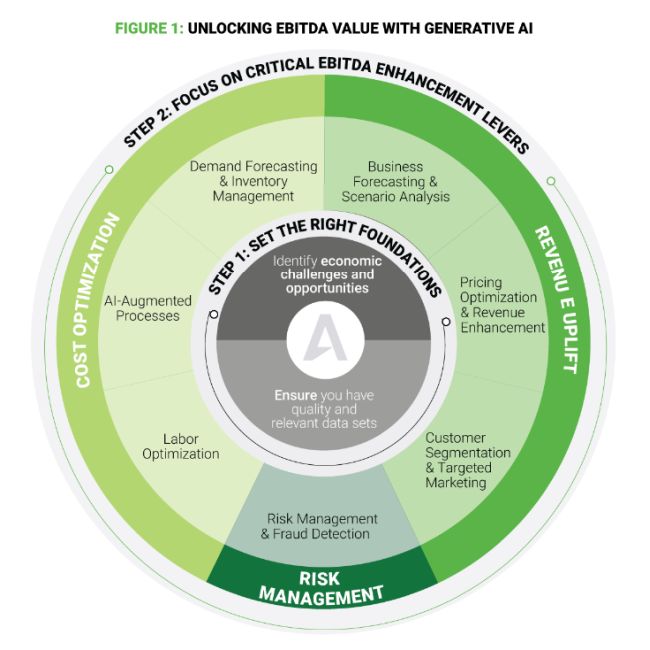In today's hyper-competitive environment, businesses constantly seek innovative strategies to drive real value and enhance financial performance. With the explosion of generative artificial intelligence, businesses now have a powerful tool at their disposal to optimize operations, streamline processes, and identify untapped revenue streams.
But how should companies be approaching (and investing in) generative AI? Below, we outline the essential first steps.
Start by asking two foundational questions.
1. What are the economic challenges and opportunities that these technologies can address for your business?
While many organizations look to harness generative AI, fewer bring a clear-eyed approach to deliver concrete results. The pressure to gain a competitive edge can affect decision-making without a clear line of sight to measurable and sustained impact.
Businesses should start with a clear view of market demand and competitive positioning. These, coupled with an understanding of the operational bottlenecks impeding growth or generating redundant cost and inefficiencies, can help you determine how to apply generative AI to generate real value. What are unmet customer needs? What drives customer churn? What costs most affect margin? Can I enhance my pricing strategies? Does my customer experience leak value? Can I optimize my production? Or even more boldly, what would happen if I gained agility of linking all the above in my processes?
Risk-managed experimentation with generative AI should be encouraged, as it can lead to creative ideas and rapid innovation and impact at the coalface of employee tasks. However, these investments and use cases should focus on making a meaningful impact on results and be managed and minded to demonstrating the value of these applications. By doing so, you can build an understanding of the costs, capabilities, and requirements needed to support and scale the implementation of these technologies.
2. Have you made the right investments in data to realize the economic potential of generative AI?
All AI outputs and insights are only as good as the data made available. Therefore, it is imperative that companies invest in developing quality and relevant data sets that provide valuable economic insights. By leveraging advanced analytical techniques, organizations can examine vast amounts of structured and unstructured data to extract valuable economic indicators, market trends, and customer behaviors.
Data sources, whether internal, external, or synthetic, must be carefully assessed for risk (e.g., privacy and the use of customer data, introducing bias, or the threat of data or AI poisoning). This data verification step is taken when defining the data sources. A further step, model validation, is an ongoing process to review how the model is learning from the data and maintain integrity of the outputs.
Once the foundations are set, explore where generative AI can be applied as an EBITDA enhancement lever.
1. Where can it provide an uplift to revenue?
Business forecasting and scenario analysis can be improved through generative AI's predictive modeling capabilities. By integrating economic data, market trends, and other relevant variables, businesses can simulate different scenarios and assess their potential impact on financial performance. This empowers organizations to make informed strategic decisions, identify opportunities, and mitigate risks. It helps drive the speed and accuracy of insight, producing agility to power EBITDA growth and value creation. Better planning processes also sustain growth, profitability, and performance by keeping the finger on the pulse of the business's response to market and customer needs.
Pricing optimization is another area where generative AI can drive EBITDA expansion. By leveraging its algorithms, organizations can dynamically adjust prices based on various economic factors, such as demand elasticity, market saturation, and competitor pricing. This approach enables businesses to maximize their revenue potential by offering personalized pricing strategies, tailored discounts, and promotional offers to different customer segments. In this way, organizations can capture higher market share, increase profit margins, and enhance their EBITDA.
Generative AI can also provide organizations with deeper insights into customer segmentation, allowing them to target their marketing efforts more effectively. By utilizing predictive modeling and clustering techniques, businesses can identify customer segments based on economic characteristics, preferences, and purchasing behavior. This enables organizations to tailor their marketing campaigns, develop personalized offerings, and improve customer acquisition and retention rates.
Furthermore, its natural language processing capabilities and sentiment analysis enables us (through prompts) to build creative content that resonates to the end consumer's sentimental and behavioral drivers, and then A/B test this content for effectiveness at speed, reducing the need for agency spend.
2. How can it help optimize costs?
Generative AI can provide analysis and insights to improve labor productivity. With AI, organizations can forecast operational demand with greater precision to align staffing levels to match demand. This helps create optimal shift schedules, taking constraints and preferences into account. It also allows for real-time adjustments in response to unexpected changes—an application we have successfully seen adopted to optimize field services, for example.
AI's ability to match staff roles based on skill, experience, and performance drives significant productivity gains. Beyond short-term support, the technology is effective at long-term planning to support future hiring decisions and training capacity requirements. Improved service levels and increased employee satisfaction are all further potential benefits.
Another area that it can reduce costs is through AI-augmented processes. Generative AI was originally used in intelligent automation tasks, which are generally repetitive, rule-based tasks to increase speed, reduce errors and improve productivity with tasks data entry, invoice processing and other routine tasks. However, its capabilities extend well beyond the automating repetitive tasks and into the area of intelligent generation, which requires creation and problem solving, such as customer service, marketing content creation, and coding solutions. By augmenting processes with generative AI, users can more rapidly create personalized customer experiences, compelling marketing content, and streamlined code, increasing their productivity. AI-augmented process enables organization to achieve gains in quality, productivity, and speed.
Accurate demand forecasting is crucial for optimizing inventory management and supply chain efficiency. Generative AI can analyze historical sales data, economic indicators, and external factors to generate highly accurate demand forecasts. This enables organizations to optimize inventory levels, reduce carrying costs, identify opportunities in the long tail spend, and minimize stockouts or excess inventory.
Generative AI's ability to leverage more data—more deeply—to generate greater insights enables businesses to align supply more closely with demand. This, in turn, enables improved working capital efficiency, reduced costs, and increased dynamism in their supplier base.
3. How can it enhance risk management?
Generative AI's capabilities for risk management and fraud detection have significant economic implications. By leveraging machine learning algorithms, organizations can analyze vast amounts of data to detect anomalies and identify potential fraud patterns. This proactive approach to risk management helps safeguard organizational assets, minimize financial losses, and protect margins.
However, generative AI also poses certain risk—either amplifying existing risks or introducing new ones. Robust mitigation strategies need to adapt to encompass the risks brought about by generative AI to enhance stakeholder confidence and maintain sustainable financial performance.
Start unlocking EBITDA value through your generative AI investments.
Generative AI represents a transformative force in driving real value and EBITDA impact for organizations. By identifying economic challenges and opportunities, optimizing pricing strategies, enhancing demand forecasting, improving operational efficiency, and mitigating risks, businesses can unlock significant economic gains.
But investments need to be driven by realizable business benefits and embedded in business processes. Generative AI is the technology of the moment, but it is not a silver bullet. Technology, in and of itself, provides no value. Like any investment, it requires a clear understanding of the ROI. Like any new capability, generative AI requires a strategic approach, cross-functional collaboration, and an engineering of data, organizations, and operations to fully, and safely, take advantage of the value creation opportunities it promises.

The content of this article is intended to provide a general guide to the subject matter. Specialist advice should be sought about your specific circumstances.



